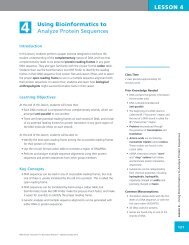WET LAB DNA Barcoding: From Samples to Sequences - Northwest ...
WET LAB DNA Barcoding: From Samples to Sequences - Northwest ...
WET LAB DNA Barcoding: From Samples to Sequences - Northwest ...
Create successful ePaper yourself
Turn your PDF publications into a flip-book with our unique Google optimized e-Paper software.
<strong>WET</strong> <strong>LAB</strong><br />
28. Show Slide #17, which shows the samples loaded in<strong>to</strong> the wells at the <strong>to</strong>p<br />
of the gel. This scientist used a micropipette <strong>to</strong> carefully load her <strong>DNA</strong> sample<br />
in<strong>to</strong> the wells.<br />
Wet Lab: Slide #17<br />
Using Bioinformatics: Genetic Research<br />
Gel box: Apparatus in which an<br />
agarose gel is run.<br />
Power supply: Used <strong>to</strong> create the<br />
electrical field <strong>to</strong> which the <strong>DNA</strong><br />
will be subjected during agarose gel<br />
electrophoresis.<br />
[Note: Some teachers (and scientists!)<br />
use the phrase “run <strong>to</strong>wards red” as a<br />
reminder that the <strong>DNA</strong> is loaded at the<br />
<strong>to</strong>p of the gel, near the black (negative)<br />
electrode, so that the <strong>DNA</strong> will “run<br />
<strong>to</strong>wards [the] red” (positive) electrode at<br />
the bot<strong>to</strong>m of the gel.]<br />
[Note: Many gel boxes can be set for<br />
“constant volts” or “constant amps”(as<br />
Watts = Amperes x Volts). In this case, be<br />
sure that “constant volts” is selected.]<br />
29. If students are not already familiar with agarose gel electrophoresis, it is<br />
strongly suggested that you show one or all of the tu<strong>to</strong>rials listed in the<br />
Materials section at the beginning of this lesson, particularly those sections<br />
related <strong>to</strong> sample loading. “<strong>DNA</strong> Electrophoresis Sample Loading” from Greg<br />
Peterson, Coordina<strong>to</strong>r of Biotechnology, Kirkwood Community College, Math/<br />
Science Department, contains the most detailed information about what <strong>to</strong> do<br />
(and what not <strong>to</strong> do) when loading <strong>DNA</strong> samples on<strong>to</strong> agarose gels.<br />
30. Show Slide #18, which illustrates the components of the gel box necessary<br />
<strong>to</strong> run the agarose gel. Review each component with your students:<br />
a. The agarose gels are run in a gel box, which is the clear plastic case shown<br />
in the pho<strong>to</strong>.<br />
b. The power supply generates the electrical current needed <strong>to</strong> move the<br />
<strong>DNA</strong> through the gel.<br />
c. The red, positive electrode connects the power supply <strong>to</strong> the bot<strong>to</strong>m of the<br />
gel box, while the black, negative electrode connects the power supply <strong>to</strong><br />
the <strong>to</strong>p of the gel box.<br />
d. Note that the <strong>DNA</strong> is negatively charged, and will therefore move <strong>to</strong>ward<br />
the positive electrode at the bot<strong>to</strong>m of the gel.<br />
e. The power supply displays how many volts and amperes (amps) are being<br />
run through the gel box. It is very important never <strong>to</strong> run the gel with more<br />
volts or amps than instructed.<br />
338<br />
©<strong>Northwest</strong> Association for Biomedical Research—Updated Oc<strong>to</strong>ber 2012
















